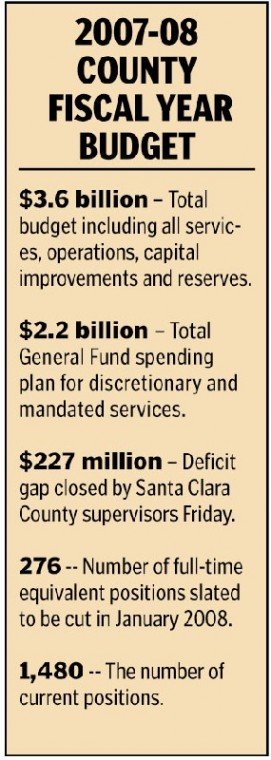Santa Clara County supervisors closed a $227 million deficit and
managed to save the San Martin health clinic, the rural crimes
sheriff’s deputy position and some South County mental-health
services before unanimously adopting a balanced $3.6-billion budget
Friday morning.
San Jose – Santa Clara County supervisors closed a $227 million deficit and managed to save the San Martin health clinic, the rural crimes sheriff’s deputy position and some South County mental-health services before unanimously adopting a balanced $3.6-billion budget Friday morning.
Mental health programs lost $17.1 million and public health and ambulatory care services lost $18.8 million. Drug and alcohol services were reduced by $2.6 million and the Santa Clara Valley Medical Center will absorb cuts totaling $32.8 million. But Community Solutions, a nonprofit that helps South County victims of domestic violence and sexual assault, retained all it’s funding.
Meanwhile, the county will maintain an emergency reserve worth 4.7 percent of the county’s estimated $1.8 billion in income in the upcoming fiscal year. An issue debated by supervisors as deep cuts to health care were made, the board will maintain the reserve level to guard against a natural disaster where federal relief may not materialize.
During the next 12 months, services for 1,000 mental-health patients, including 363 children, will be eliminated. The District Attorney’s office will eliminate its cold-case unit and its life-sentences hearings program, which helps victims of violent crimes when their offenders are up for parole.
Supervisors adopted the budget at the end of a gut-wrenching week of hearings at the County Government Building in San Jose. The hearings were the last important step in a challenging budget-planning process that began last summer.
“It’s tough to always be compassionate when you’re making cuts to our ‘safety net’ of services,” Supervisor Don Gage said during the hearing, which was attended by more than 100 county employees, many of whom watched the budget process unfold for months. “We tried to do the best we could with what we had.”
As in previous deficit years, the county relied on cuts and layoffs to help plug the shortfall, slashing on-going law-enforcement, criminal justice, health-care and social programs by $118 million and eliminating about 280 jobs. The Santa Clara County Sheriff’s Department is being cut by roughly $3 million.
While the county won’t offer any budget-related retirement incentives, it’s anticipated that in December a number of employees may chose to retire to take advantage of a previously approved change in retirement benefits that may entitle some workers to a larger pension. The benefit is “employee-funded,” according to the county, meaning employees will pay for it out of their paychecks.
The approved spending cuts will not eliminate legally mandated services for the county’s roughly 1.7 million residents, but supervisors fear the recent string of necessary budget cuts is decimating the county’s “safety net” of services for people who lack health insurance and other benefits.
More than 80 percent of the county’s revenues come from state and federal sources that have dwindled in recent years. Meanwhile, the cost of administering and offering services continues to rise, especially as health care becomes more expensive nationwide.
Earlier this year, the county feared it would have to slash $146 million in on-going social, health-care, public safety and criminal justice programs, but administrators reduced the targeted cuts by nearly $30 million to $118 million, thanks to unexpected state revenue and money from proposed fees, among other things.
“It’s better than we anticipated, in terms of the funding,” said Miguel Valencia, director of Gardner Family Care, a nonprofit provider of mental health services in San Jose and Gilroy that receives county funding to treat some 50,000 people with sever mental illnesses every year. “Clearly, these services are important. We serve the most needy populations, people who don’t have health insurance, suffering from severe depression and schizophrenia.”
Valencia said the treatment patients receive at Gardner keeps them out of emergency rooms where they’d rack up large bills for taxpayers.
Supervisors also approved money to save 40 nursing positions and keep the San Martin health clinic on Highland Avenue open.
“We would have been reduced to disease control only” had the funding not been allocated, said Ira Schwartz, director of Santa Clara County public health nursing, who last October feared his crew would drop from 67 to 27 nurses. “Now we’ll be able to continue seeing people who are coming out of the Neonatal Intensive Care Unit (at Santa Clara Valley Medical Center in San Jose) and visit children with asthma and frail elderly at their homes.”
While placated by some of the restorations, some say the road ahead is gloomy as more deficits loom.
“I think it’s an amazing outcome to maintain vital services we need and still be fiscally responsible,” said Erin O’Brien, director of Community Solutions, the non-profit human services provider that faced $750,000 in county-funding cuts earlier this year. “What’s daunting is what’s to come.” Next year, county officials expect another deficit surpassing $100 million.
Final details will be made available this summer as administrators begin yet another painful budget-making cycle that will surely include more cuts and more layoffs.
“It’s a stressful process that adds a lot of distractions” on top of the work county employees do, said Gary Graves, deputy county executive for Santa Clara County. “You wonder how many times you can put the organization through this.”
To close this year’s deficit gap, the county also relied on $9 million worth of unexpected state revenue; $31.5 million from Santa Clara Valley Medical Center reserves; $10 million in savings by making a lump-sum PERS retirement contribution rather than spreading it out over the course of the year; $6.1 million from sale of pension obligation bonds; and $7.5 million from the city of San Jose stemming from a legal settlement.
Additionally, two fee proposals could generate at least $2 million for the county during fiscal year 2007-08.
One fee proposal is a countywide fee of 27.3 cents per phone line for all county phones – including cell phones – to support various emergency services to the tune of $6.7 million per year. If approved later this year by supervisors, it would take effect in February 2008.
Supervisors also asked administrators to prepare a ballot measure to establish a new special district to fund Sheriff’s patrol costs.













